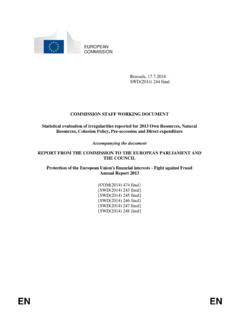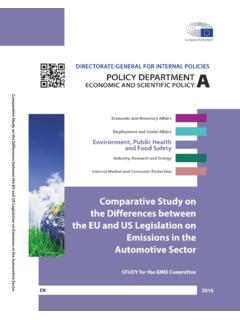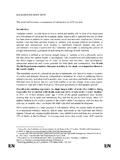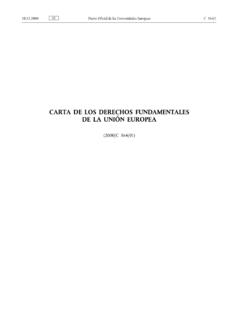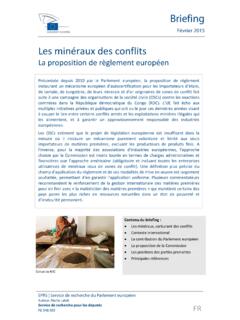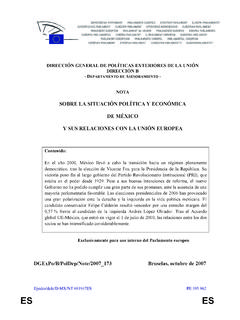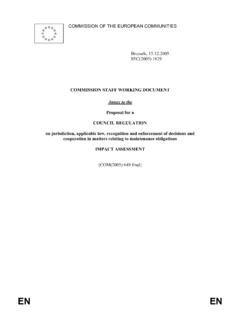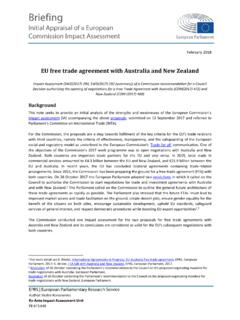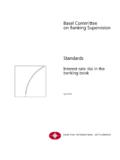Transcription of The Determination of Interest Rates - European Parliament
1 Directorate-General for Research WORKING PAPER. The Determination of Interest Rates Economic Affairs Series ECON 116 EN. This publication is available in EN (original), FR and DE. A summary is available in all the Community languages PUBLISHER: European Parliament L-2929 Luxembourg AUTHORS: Ben Patterson and Kristina Lygnerud EDITOR: Ben Patterson Directorate General for Research Economic, Monetary and Budgetary Affairs Division Tel.: (00352)4300-24114. Fax: (00352)4300-27721. E-Mail: GPATTERSON. Internet: The opinions expressed is this working paper are those of the authors and do not necessarily reflect the position of the European Parliament . Reproduction and translation of this publications are authorised, except for commercial purposes, provided that the source is acknowledged and that the publisher is informed in advance and supplied with a copy.
2 Manuscript completed in December 1999. Directorate-General for Research WORKING PAPER. The Determination of Interest Rates Economic Affairs Series ECON 116 EN. 11-1999. Interest Rates . EXECUTIVE SUMMARY. The charging of Interest for lending money has not always been an acceptable practice. Usury . is specifically condemned in both the Bible and in Shari'ah law, and modern Islamic banks operate only on the basis of profit. In modern financial markets, however, the distinctions between Interest , rent, profit and capital appreciation are not clear-cut. The current hotly-debated proposal on the taxation of Interest within the EU has illustrated the difficulty of reaching legally precise definitions. In economic theory, Interest is the price paid for inducing those with money to save it rather than spend it, and to invest in long-term assets rather than hold cash.
3 Rates reflect the interaction between the supply of savings and the demand for capital; or between the demand for and the supply of money. Rates of Interest can be expressed as a percentage payable (a coupon ), usually per annum; or as the present discounted value of a sum payable at some future date (the date of maturity ). There is an inverse relationship between the prevailing rate of Interest at any one time, and the discounted value at that time of assets paying Interest : bond prices fall when yields increase. An important distinction must be made between nominal and real Interest Rates . A real rate of Interest is the nominal coupon rate, less the rate at which money is losing its value. Calculating real Rates , however, presents methodological problems, since there are significantly different ways of calculating Rates of inflation.
4 Inflationary expectations, however, are one of the most important determinants of Interest Rates . Broadly, savers demand a real return from their investments. Changes in the forecasts of future inflation are therefore reflected in the current prices of assets. The effect on bonds of varying maturity, for example, can be charted as shifts in the yield curve . Rates of Interest also reflect varying degrees of risk. A body with a rock-solid credit-rating, like the European Investment Bank, will be able to attract savings at a very much lower Rates of Interest than corporate issuers of junk bonds . Countries with high levels of existing debt may have to pay higher Rates on government borrowing than countries where the risk of default is less.
5 Indeed, the guarantee that sovereign debt will be repaid on maturity has frequently allowed governments to borrow at negative real Rates of Interest . Within any economy there will therefore be a multiplicity of Interest Rates , reflecting varying expectations and risks . The markets for different assets physical and financial will influence each other as savers shift their portfolios between cash, Interest -bearing securities, equity in firms, complex derivatives, real estate, antiques, etc. Financial institutions and large corporations will behave differently from small savers and small businesses. v PE Interest Rates . Short-term Rates Money market levels of overnight (up to a week) and short-term (up to a year) Interest Rates are heavily influenced by the Rates set by Central Banks.
6 In the case of the euro area, the European System of Central Banks (ESCB) can use its power as the monopoly supplier of cash to set a floor and a ceiling to overnight and short Rates (the Deposit Rate and the Marginal Lending Rate), as well as setting a benchmark central rate (the Marginal Refinancing Rate or repo rate). Central Banks with the primary remit of price stability like the European Central Bank (ECB). itself will set short-term Rates so as to prevent future inflation. Higher current Rates should encourage people to save rather than spend, and businesses to defer capital spending. Neutral . Rates will be just high enough to fend off future inflation, but not so high as to choke off economic growth and raise unemployment.
7 There are a number of problems in implementing this theoretical model, however. Political support for the price-stability objective is not guaranteed. An alternative objective, for example, might be the maintenance of full employment, with Interest Rates being kept low to boost investment. Or nominal Rates might only be changed to maintain real Rates at some agreed level. It is difficult, if not impossible, to determine what neutral Rates might be at any one time. Estimating inflationary risk is a matter of judgement, based on data of varying accuracy. The ECB operates a twin pillar approach, based on a reference level for the annualised growth rate in the monetary aggregate M3; and a broadly based assessment of the outlook for price developments , based on a range of other indicators: bond yields, consumer credit, the exchange rate, etc.
8 There is uncertainty about the transmission mechanisms through which Central Bank Interest Rates feed through into market Rates . Variations between different national economies and regions occur as a result of differences in the sources of corporate finance, the level and structure of corporate and household debt, and the degree of competition in the financial services industry. Little can be adduced from past experience, since financial systems are currently in a state of flux as a result of monetary union itself (the Lucas critique). National economies are increasingly open to the influence of international financial markets. Short-term capital can move rapidly between currency areas in search of higher returns, disrupting the operation of domestic monetary policy.
9 This can lead to conflicts of the kind which faced the UK in September 1992, when higher Interest Rates were required to avoid a Sterling depreciation and to keep it within the European Monetary System's Exchange Rate Mechanism but lower Rates to avoid a recession. The comparatively low proportion of euro area GDP which is traded, by comparison with the individual Member States' currency areas, has reduced, but not eliminated, such vulnerability. vi PE Interest Rates . Long-term Rates The existence of global financial markets ensures that real long-term Interest Rates tend to move together in different economies. Nominal long-term Rates , however, reflect inflationary expectations in the separate economies, which in turn reflect the credibility of domestic monetary policy.
10 Linked to inflationary expectations are exchange-rate expectations; but exchange-rate movements can also take place for reasons unconnected to inflation differentials. Economic theory in this area has a bad record of prediction. The effect of short-term Interest rate changes on long-term Rates is not, therefore, straightforward. A rise in short-term Rates can lead to, or be contemporary with, a rise in long Rates ; but also to a fall if the markets are convinced that future inflation has been prevented. National fiscal policies have also played a major part in determining long-term Interest Rates . Where budget deficits and/or the total level of government debt have been high, the need to borrow for current spending and to re-finance maturing debt has forced up long-term Rates .
